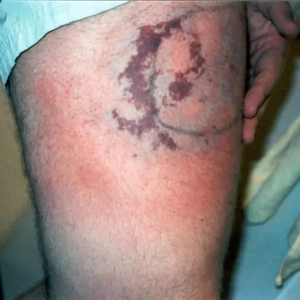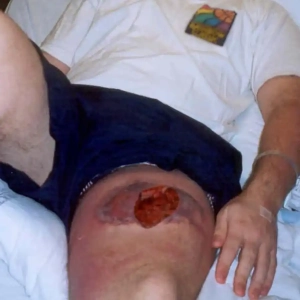Brown Recluse Spider Bite
Like many other spider bites, the brown recluse spider bite is tough to feel; if anything, the bite would feel like a pinprick if even noticed. The brown recluse is one of four poisonous spiders. In fact, only 60 out of 20,000 species of spiders can bite at all.
The brown recluse is not an aggressive spider, and the only way one would bite is if one feel threatened. This is usually caused by the brown recluse feeling trapped, which can happen if caught in clothes or pressed between the skin and another surface.
Spider Bite Reaction
Above you can see pictures that Dale and Meg shared with us. Here is Dale’s story:
Yikes! Spider bite
I was bitten by a brown recluse spider while lying in bed. The first day I went to the hospital, they gave me an aspirin and told me to go home to sleep the bite away.
The next day I was rushed to the emergency room and told I was a fraction of the time away from losing my leg or life. After nine days in the hospital, they removed the dead tissue. What I had left was a 12-inch diameter hole in my leg.
After a scar rescission surgery last year, the plate size hole in my leg reduced in size. The apartment I was in collected around 24 spiders, all of which were brown recluse spiders. When I told the manager, he laughed until he saw my leg and fainted.
Even after all that, it took the local Health Department to make him spray for bugs.
The next time I see brown spiders strolling around my apartment, I am packing my bags.
Dale L.
The physical reaction to a brown recluse spider bite depends on the amount of venom injected and how the victim’s body reacts to the venom. While some notice the bite immediately due to immense pain, others do not notice the bite for several hours, which can be extremely dangerous. Some do not react to a brown recluse spider bite, while others can be severely injured.
Some reactions to brown recluse spider bites are fever, chills, itching, going into shock, vomiting, and restlessness. Initially, a small white blister will appear where the brown recluse bit, and the skin surrounding the newly formed blister will also become swollen. Later as the area becomes infected, it will get extremely red in color, and the tissue becomes rather hard.
The bite area from a Brown Recluse Spider is usually dry, blue-gray, or blue-white, with an irregular sinking patch with torn edges and extremely red. The deep and sore wound from the brown recluse usually takes a long time to heal. Death usually will not occur; however, the risk is higher in young children and the elderly.
When there is a reaction to the brown recluse’s venom, the bite forms almost like a volcano lesion. The open wound can range anywhere from a few centimeters to a few inches in size. The open sour can take 6 to 8 weeks to heal completely. After that, the complete recovery can take several months.
Brown Recluse Spider Bite Treatment
Victims should seek medical attention immediately after being bitten by any spider because many are unaware if a spider is poisonous. It helps to bring in the spider so the doctor can identify whether or not the bite is dangerous (but don’t try to capture it if you can’t do it safely or feel uncomfortable, instead, take a picture from a safe distance).
Many doctors will give high doses of cortisone-type hormones to help defeat hemolysis and other systemic complications. Other treatments depending on the case sometimes is also administered.






